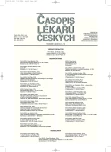Past, present and future of neuroprotection
Authors:
Jan Mraček
Authors‘ workplace:
Univerzita Karlova v Plzni, Lékařská fakulta, Neurochirurgické oddělení FN
Published in:
Čas. Lék. čes. 2010; 149: 586-590
Category:
Review Article
Overview
The aim of neuroprotection is to rescue ischemic tissue and improve functional outcome by intervention on ischemic cascade. A lot of experimental trials demonstrated that neuroprotection is effective in infarction volume reduction. Unfortunately most of the effective agents in preclinical studies failed in clinical trials. None of tested neuroprotective agents have shown to improve outcome in clinical trial phase III up to now. The main reasons that may have caused the failure of past clinical trials are: extended therapeutic window, heterogeneous population of stroke patients, low dose administration, inadequate endpoints, discrepancies on outcome assessments in experimental and clinical trials, irregular study design and inadequate statistical evaluation. Future of neuroprotection is seen in concentration on the subgroup with existing penumbra, the combination of neuroprotection and thrombolysis and in prophylactic neuroprotection. The unification of the design in experimental and clinical trials is the main prerequisite for potential success in the clinical testing.
Key words:
neuroprotection, stroke, ischemia, penumbra, therapeutic window, clinical trials.
Sources
1. Ginsberg MD. Neuroprotection for ischemic stroke: past, present and future. Neuropharmacology 2008; 55(3): 363–389.
2. Ehler E. Cévní mozkové příhody – neuroprotektivní léčba. Neurol pro praxi 2001; 4: 173–177.
3. Kalvach P, et al. Mozkové ischemie a hemoragie. Praha: Grada Publishing 2010.
4. Kalita Z, et al. Akutní cévní mozkové příhody. Praha: Maxdorf Jessenius 2006.
5. Fisher M. The ischemic penumbra: identification, evolution and treatment concepts. Cerebrovasc Dis 2004; 17(Suppl 1): 1–6.
6. Ginsberg MD. Current status of neuroprotection for cerebral ischemia: synoptic overview. Stroke 2009; 40: 111–114.
7. Savitz SI, Fisher M. Future of neuroprotection for acute stroke: in the aftermath of the SAINT trials. Ann Neurol 2007; 61: 396–402.
8. O’Collins VE, Macleod MR, Donnan GA, Horky LL, van der Worp BH, Howells DW. 1,026 experimental treatments in acute stroke. Ann Neurol 2006; 59: 467–477.
9. Lees KR, Zivin JA, Ashwood T, Davalos A, Davis SM, Diener HC, et al. NXY–059 for acute ischemic stroke. N Engl J Med 2006; 354(6): 588–600.
10. Shuaib A, Lees KR, Lyden P, Grotta J, Davalos A, Davis SM, et al. NXY–059 for the treatment of acute ischemic stroke. N Engl J Med 2007; 357(6): 562–571.
11. Cheng YD, Al-Khoury L, Zivin JA. Neuroprotection for ischemic stroke: two decades of success and failure. NeuroRx 2004; 1: 36–45.
12. Dewar D, Yam P, McCulloch J. Drug development for stroke: importance of protecting cerebral white matter. Eur J Pharmacol 1999; 375: 47–50.
13. Demchuk AM, Buchan AM. Predictors of stroke outcome. Neurol Clin 2001; 18: 455–473.
14. Labiche A, Grotta JC. Clinical trials for cytoprotection in stroke. NeuroRx 2004; 1: 46–70.
15. Fisher M, Schaebitz W. An overview of acute stroke therapy. Arch Intern Med 2000; 27: 3196–3205.
16. Ebisu T, Mori Y, Katsuta K. Neuroprotective effect of an immunosuppresant agent on diffusion/perfusion mismatch in transient focal ischemia. Magn Reson Med 2004; 51: 1173–1180.
17. Furlan AJ, Eyding D, Albers WW. Dose escalation of Desmoteplase for Acute Ischemic Stroke (DEDAS): evidence of safety and efficacy 3 to 9 hours after stroke onset. Stroke 2006; 37: 1227–1231.
18. Zivin JA, Mazzarella V. Tissue plasminogen activator plus glutamate antagonist improves outcome after embolic stroke. Arch Neurol 1991; 48: 1235–1238.
19. Lyden PD, Lonzo L, Nunez S. Combination chemotherapy extends the therapeutic window to 60 after stroke. J Neurotrauma 1995; 12: 223–230.
20. Savitz SI, Fisher M. Prophylactic neuroprotection. Current Drug Targets 2007; 8: 846–849.
21. Wolf PA, D‘Agostino RB, Belanger AJ, Kannel WB. Stroke 1991; 22(3): 312–318. Probability of stroke: a risk profile from the Framingham Study.
22. Johnston SC, Gress DR, Browner WS, Sidney S. Short-term prognosis after emergency department diagnosis of TIA. JAMA 2000; 284(22): 2901–2906.
23. Rothwell PM, Giles MF, Flossmann E, Lovelock CE, Redgrave JN, Warlow CP, Mehta Z. A simple score (ABCD) to identify individuals at high early risk of stroke after transient ischaemic attack. Lancet 2005; 366(9479): 29–36.
Labels
Addictology Allergology and clinical immunology Angiology Audiology Clinical biochemistry Dermatology & STDs Paediatric gastroenterology Paediatric surgery Paediatric cardiology Paediatric neurology Paediatric ENT Paediatric psychiatry Paediatric rheumatology Diabetology Pharmacy Vascular surgery Pain management Dental HygienistArticle was published in
Journal of Czech Physicians

Most read in this issue
- Kidney diseases in pregnancy
- Past, present and future of neuroprotection
- Demographic view on primary health care physicians in the Czech Republic – present state as the headstone for the future development
- Alcohol in children and adolescents – prevention and treatment
